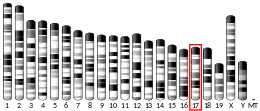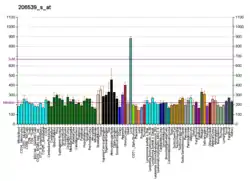Cytochrome P450 4F12 is a protein that in humans is encoded by the CYP4F12 gene.[5][6]
This gene encodes a member of the cytochrome P450 superfamily of enzymes and is part of a cluster of cytochrome P450 genes on chromosome 19.[6][7] The cytochrome P450 proteins are monooxygenases which catalyze many reactions involved in drug metabolism and synthesis of cholesterol, steroids and other lipids. This protein likely localizes to the endoplasmic reticulum. CYP4F12 is expressed in the liver and throughout the gastrointestinal track, is known to metabolize the anti-histamine drugs, ebastine and terfenadine, and therefore is suggested to be positioned for and possibly involved in the processing of these and perhaps other drugs.[7][8]
When expressed in yeast the enzyme is capable of oxidizing arachidonic acid by adding a hydroxyl residue to carbons 18 or 19 to form 18-hydroxyeicosatetraenoic acid (18-HETE) or 19-HETE; however, its physiological function in doing so has not been determined. CYP4F12 also metabolizes prostaglandin H2 (PGH2) and PGH1 to their corresponding 19-hydroxyl analogs in a reaction that might serve to reduce their activities.[9] In addition to these monooxygenase actions, CYP458 possesses epoxygenase activity: it metabolizes the omega-3 fatty acids, docosahexaenoic acid (DHA) and eicosapentaenoic acid, (EPA) to their corresponding epoxides, the epoxydocosapentaenoic acids (EDPs) and epoxyeicosatetraenoic acids (EEQs), respectively.[10] The enzyme metabolizes DHA primarily to 19R,20S-epoxyeicosapentaenoic acid and 19S,20R-epoxyeicosapentaenoic acid isomers (termed 19,20-EDP) and EPA primarily to 17R,18S-eicosatetraenoic acid and 17S,18R-eicosatetraenoic acid isomers (termed 17,18-EEQ).[10] 19-HETE is an inhibitor of 20-HETE, a broadly active signaling molecule which acts to constrict arterioles, elevate blood pressure, promote inflammation responses, and stimulates the growth of various types of tumor cells; however the in vivo ability and significance of 19-HETE in inhibiting 20-HETE has not been demonstrated (see 20-Hydroxyeicosatetraenoic acid). The EDPs (see Epoxydocosapentaenoic acid) and EEQs (see epoxyeicosatetraenoic acid) have a broad range of activities. In various animal models and in vitro studies on animal and human tissues, they decrease hypertension and pain perception; suppress inflammation; inhibit angiogenesis, endothelial cell migration and endothelial cell proliferation; and inhibit the growth and metastasis of human breast and prostate cancer cell lines.[11][12][13][14] It is suggested that the EDP and EEQ metabolites function in humans as they do in animal models and that, as products of the omega-3 fatty acids, DHA acid and EPA, the EDP and EEQ metabolites contribute to many of the beneficial effects attributed to dietary omega-3 fatty acids.[11][14][15] EDP and EEQ metabolites are short-lived, being inactivated within seconds or minutes of formation by epoxide hydrolases, particularly soluble epoxide hydrolase, and therefore act locally.
The fatty acid metabolizing activity, including the ability to form epoxides, of CYP4F12 is very similar to that of CYP4F8. However, it and CYP4F8 are not regarded as being major contributors in forming the cited epoxides in humans although they might do so in tissues where they are highly expressed.[9]
References
- 1 2 3 GRCh38: Ensembl release 89: ENSG00000186204 - Ensembl, May 2017
- 1 2 3 GRCm38: Ensembl release 89: ENSMUSG00000024292 - Ensembl, May 2017
- ↑ "Human PubMed Reference:". National Center for Biotechnology Information, U.S. National Library of Medicine.
- ↑ "Mouse PubMed Reference:". National Center for Biotechnology Information, U.S. National Library of Medicine.
- ↑ Bylund J, Bylund M, Oliw EH (Feb 2001). "cDna cloning and expression of CYP4F12, a novel human cytochrome P450". Biochem Biophys Res Commun. 280 (3): 892–7. doi:10.1006/bbrc.2000.4191. PMID 11162607.
- 1 2 "Entrez Gene: CYP4F12 cytochrome P450, family 4, subfamily F, polypeptide 12".
- 1 2 Stark, Katarina; Wongsud, Buanus; Burman, Robert; Oliw, Ernst H. (15 September 2005). "Oxygenation of polyunsaturated long chain fatty acids by recombinant CYP4F8 and CYP4F12 and catalytic importance of Tyr-125 and Gly-328 of CYP4F8". Archives of Biochemistry and Biophysics. 441 (2): 174–181. doi:10.1016/j.abb.2005.07.003. ISSN 0003-9861. PMID 16112640.
- ↑ Johnson, Amanda L.; Edson, Katheryne Z.; Totah, Rheem A.; Rettie, Allan E. (1 January 2015). "Cytochrome P450 ω-Hydroxylases in Inflammation and Cancer". Cytochrome P450 Function and Pharmacological Roles in Inflammation and Cancer. Advances in Pharmacology. Vol. 74. pp. 223–262. doi:10.1016/bs.apha.2015.05.002. ISBN 9780128031193. ISSN 1557-8925. PMC 4667791. PMID 26233909.
- 1 2 Johnson AL, Edson KZ, Totah RA, Rettie AE (2015). "Cytochrome P450 ω-Hydroxylases in Inflammation and Cancer". Cytochrome P450 Function and Pharmacological Roles in Inflammation and Cancer. Advances in Pharmacology. Vol. 74. pp. 223–62. doi:10.1016/bs.apha.2015.05.002. ISBN 9780128031193. PMC 4667791. PMID 26233909.
- 1 2 Westphal C, Konkel A, Schunck WH (November 2011). "CYP-eicosanoids--a new link between omega-3 fatty acids and cardiac disease?". Prostaglandins & Other Lipid Mediators. 96 (1–4): 99–108. doi:10.1016/j.prostaglandins.2011.09.001. PMID 21945326.
- 1 2 Fleming I (October 2014). "The pharmacology of the cytochrome P450 epoxygenase/soluble epoxide hydrolase axis in the vasculature and cardiovascular disease". Pharmacological Reviews. 66 (4): 1106–40. doi:10.1124/pr.113.007781. PMID 25244930. S2CID 39465144.
- ↑ Zhang G, Kodani S, Hammock BD (January 2014). "Stabilized epoxygenated fatty acids regulate inflammation, pain, angiogenesis and cancer". Progress in Lipid Research. 53: 108–23. doi:10.1016/j.plipres.2013.11.003. PMC 3914417. PMID 24345640.
- ↑ He J, Wang C, Zhu Y, Ai D (December 2015). "Soluble epoxide hydrolase: A potential target for metabolic diseases". Journal of Diabetes. 8 (3): 305–13. doi:10.1111/1753-0407.12358. PMID 26621325.
- 1 2 Wagner K, Vito S, Inceoglu B, Hammock BD (October 2014). "The role of long chain fatty acids and their epoxide metabolites in nociceptive signaling". Prostaglandins & Other Lipid Mediators. 113–115: 2–12. doi:10.1016/j.prostaglandins.2014.09.001. PMC 4254344. PMID 25240260.
- ↑ Fischer R, Konkel A, Mehling H, Blossey K, Gapelyuk A, Wessel N, von Schacky C, Dechend R, Muller DN, Rothe M, Luft FC, Weylandt K, Schunck WH (March 2014). "Dietary omega-3 fatty acids modulate the eicosanoid profile in man primarily via the CYP-epoxygenase pathway". Journal of Lipid Research. 55 (6): 1150–1164. doi:10.1194/jlr.M047357. PMC 4031946. PMID 24634501.
External links
- Human CYP4F12 genome location and CYP4F12 gene details page in the UCSC Genome Browser.
Further reading
- Simpson AE (1997). "The cytochrome P450 4 (CYP4) family". Gen. Pharmacol. 28 (3): 351–9. doi:10.1016/S0306-3623(96)00246-7. PMID 9068972.
- Knight JA, Fronk S, Haymond RE (1975). "Chemical basis and specificity of chemical screening tests for urinary vanilmandelic acid". Clin. Chem. 21 (1): 130–3. doi:10.1093/clinchem/21.1.130. PMID 1116264.
- Hashizume T, Imaoka S, Hiroi T, et al. (2001). "cDNA cloning and expression of a novel cytochrome p450 (cyp4f12) from human small intestine". Biochem. Biophys. Res. Commun. 280 (4): 1135–41. doi:10.1006/bbrc.2000.4238. PMID 11162645.
- Strausberg RL, Feingold EA, Grouse LH, et al. (2003). "Generation and initial analysis of more than 15,000 full-length human and mouse cDNA sequences". Proc. Natl. Acad. Sci. U.S.A. 99 (26): 16899–903. Bibcode:2002PNAS...9916899M. doi:10.1073/pnas.242603899. PMC 139241. PMID 12477932.
- Clark HF, Gurney AL, Abaya E, et al. (2003). "The secreted protein discovery initiative (SPDI), a large-scale effort to identify novel human secreted and transmembrane proteins: a bioinformatics assessment". Genome Res. 13 (10): 2265–70. doi:10.1101/gr.1293003. PMC 403697. PMID 12975309.
- Ota T, Suzuki Y, Nishikawa T, et al. (2004). "Complete sequencing and characterization of 21,243 full-length human cDNAs". Nat. Genet. 36 (1): 40–5. doi:10.1038/ng1285. PMID 14702039.
- Stark K, Wongsud B, Burman R, Oliw EH (2005). "Oxygenation of polyunsaturated long chain fatty acids by recombinant CYP4F8 and CYP4F12 and catalytic importance of Tyr-125 and Gly-328 of CYP4F8". Arch. Biochem. Biophys. 441 (2): 174–81. doi:10.1016/j.abb.2005.07.003. PMID 16112640.
- Otsuki T, Ota T, Nishikawa T, et al. (2007). "Signal sequence and keyword trap in silico for selection of full-length human cDNAs encoding secretion or membrane proteins from oligo-capped cDNA libraries". DNA Res. 12 (2): 117–26. doi:10.1093/dnares/12.2.117. PMID 16303743.
- Kimura K, Wakamatsu A, Suzuki Y, et al. (2006). "Diversification of transcriptional modulation: large-scale identification and characterization of putative alternative promoters of human genes". Genome Res. 16 (1): 55–65. doi:10.1101/gr.4039406. PMC 1356129. PMID 16344560.




